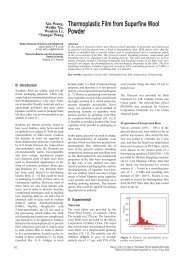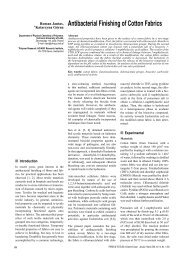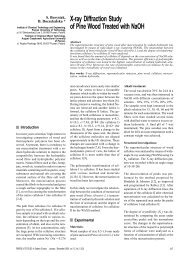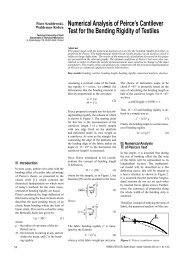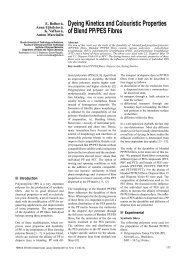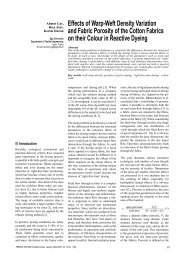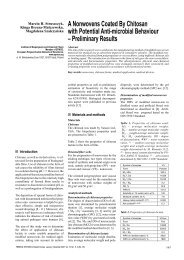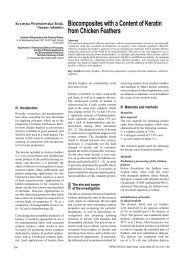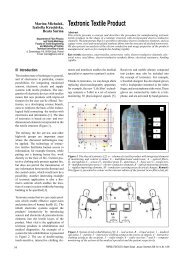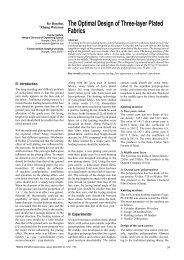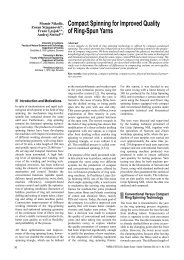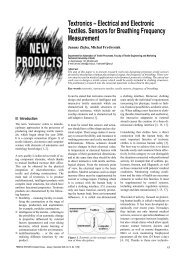Full text - Fibres & Textiles in Eastern Europe
Full text - Fibres & Textiles in Eastern Europe
Full text - Fibres & Textiles in Eastern Europe
Create successful ePaper yourself
Turn your PDF publications into a flip-book with our unique Google optimized e-Paper software.
n Introduction<br />
76<br />
Hs<strong>in</strong>g Wen-Hao,<br />
*Kao Kuo-T<strong>in</strong>g,<br />
*L<strong>in</strong> Jia-Horng,<br />
**Shu Yi-T<strong>in</strong>g<br />
Department of Textile Eng<strong>in</strong>eer<strong>in</strong>g,<br />
Ch<strong>in</strong>ese Culture University,<br />
Taipei 11192, Taiwan, R.O.C<br />
E-mail: hs<strong>in</strong>g@faculty.pccu.edu.tw<br />
*Laboratory of Fibre Application<br />
and Manufactur<strong>in</strong>g,<br />
Graduated Institute of Textile Eng<strong>in</strong>eer<strong>in</strong>g,<br />
Feng Chia University,<br />
Taichung 40724, Taiwan, R.O.C<br />
E-mail: p9126306@fcu.edu.tw<br />
**Institute of Biomedical Eng<strong>in</strong>eer<strong>in</strong>g,<br />
Chung Yuan Christian University,<br />
Chung-Li 32023, Taiwan, R.O.C<br />
The manufactur<strong>in</strong>g processes for nonwoven<br />
fabrics <strong>in</strong>variably consist of two<br />
dist<strong>in</strong>ct phases, web formation and subsequent<br />
bond<strong>in</strong>g. All nonwoven fabrics<br />
are based on fibrous webs. Therefore, the<br />
characteristics of the web determ<strong>in</strong>e the<br />
physical properties of the f<strong>in</strong>al product.<br />
A satisfactory web for nonwoven fabric<br />
production of a specific weight is produced<br />
with m<strong>in</strong>imum weight variation<br />
along its length or across its width, and<br />
hence it is difficult to discuss nonwoven<br />
fabrics without reference to this essential<br />
process. Of all the fibre web-form<strong>in</strong>g<br />
methods, the card<strong>in</strong>g method is regarded<br />
as a conventional fibre web form<strong>in</strong>g system;<br />
however, the carded web process<br />
faces a challenge from the high production<br />
of new methods of web form<strong>in</strong>g.<br />
Thus, it is more important to improve<br />
the web quality and production for the<br />
carded web process.<br />
Card<strong>in</strong>g is a basic process <strong>in</strong> the production<br />
of yarns and fibre webs of<br />
nonwoven fabrics to disentangle fibre<br />
stock <strong>in</strong>to <strong>in</strong>dividual fibres with m<strong>in</strong>imum<br />
fibre breakage and parallelisation<br />
distribution, and then convert the fibres<br />
<strong>in</strong>to the form of a web. Card<strong>in</strong>g action is<br />
the most important k<strong>in</strong>d of mat<strong>in</strong>g surface<br />
<strong>in</strong>teraction <strong>in</strong> the card<strong>in</strong>g mach<strong>in</strong>e. To<br />
have a card<strong>in</strong>g <strong>in</strong>teraction, the teeth of<br />
both the mat<strong>in</strong>g surfaces must be <strong>in</strong> a<br />
hold state relative to the fibre load. The<br />
Investigation of Nonwoven Card<strong>in</strong>g<br />
Process with the Application<br />
of Static Electricity to Various <strong>Fibres</strong><br />
and Process Parameters<br />
Abstract<br />
This paper is one of a series of studies on the carded-web form<strong>in</strong>g process with the application<br />
of static electricity to carded nonwoven fabric process. Electrostatic card<strong>in</strong>g technology<br />
was used to apply static electricity to the worker-roller of the card<strong>in</strong>g mach<strong>in</strong>e, <strong>in</strong> which the<br />
electrostatic application could change the fibre transformation, to improve the fibre load<strong>in</strong>g<br />
of card<strong>in</strong>g and then <strong>in</strong>crease the card<strong>in</strong>g performance and fibre web uniformity. Furthermore,<br />
the fibre load of the card<strong>in</strong>g element, the surface potential on the roller and the uniformity<br />
and nep count of the fibre web would be measured to <strong>in</strong>vestigate the effect of the applied<br />
static electricity on the card<strong>in</strong>g performance of different types of fibres at various process<br />
parameters. The results showed that there was a relationship between the applied static<br />
electricity and the fibre load<strong>in</strong>g of card<strong>in</strong>g roller. It signified that the electrostatic method<br />
affected the uniformity of nonwoven fabric. In addition, it was found that the change of fibre<br />
load<strong>in</strong>g on the worker-roller depended on the polarities <strong>in</strong> those tribo-electrification process,<br />
as well as those that the static electricity was applied to.<br />
Key words: static electricity, carded nonwoven fabric, fibre web, card<strong>in</strong>g performance.<br />
result is a disaggregation of fibre tufts<br />
with a portion of the fibre claimed by<br />
both surfaces. Fibre distributions (fibre<br />
load<strong>in</strong>g) on card<strong>in</strong>g elements cont<strong>in</strong>ue<br />
to <strong>in</strong>terest researchers because their<br />
distribution and translation will affect<br />
fibre openness, mix<strong>in</strong>g, and web quality,<br />
etc. [1, 2]. Additionally, over the last<br />
30 years numerous developments <strong>in</strong> the<br />
design and work<strong>in</strong>g conditions of card<strong>in</strong>g<br />
mach<strong>in</strong>es have taken place. These <strong>in</strong>clude<br />
high-speed card<strong>in</strong>g, modified<br />
feed systems, multiple take-<strong>in</strong> rollers,<br />
additional card<strong>in</strong>g segments, improved<br />
wire cloth<strong>in</strong>g, and so on [3].<br />
This work proposes a technical <strong>in</strong>novation<br />
for card<strong>in</strong>g technology achieved<br />
by apply<strong>in</strong>g the static electricity to<br />
the card<strong>in</strong>g element for a roller card.<br />
Although as everyone knows static<br />
electricity cause great damage <strong>in</strong> our<br />
life and dur<strong>in</strong>g <strong>in</strong>dustrial production , it<br />
also has many applications <strong>in</strong> the <strong>text</strong>ile<br />
<strong>in</strong>dustry, such as flock<strong>in</strong>g products, filters,<br />
etc. In several research works [4-7],<br />
static electricity was used to control the<br />
fibre movement <strong>in</strong> the fibre web, sliver<br />
and composite form<strong>in</strong>g. Thus, we expect<br />
to utilise the characteristics of static<br />
electricity to manufacture carded-web<br />
nonwoven fabrics and improve the<br />
card<strong>in</strong>g action and web quality. In previous<br />
studies [8, 9], we attempted to apply<br />
static electricity to the card<strong>in</strong>g mach<strong>in</strong>e<br />
to improve the card<strong>in</strong>g efficacy. The<br />
results of previous studies seemed to<br />
show a relationship between the measured<br />
surface potential of the worker-roller,<br />
the fibre load<strong>in</strong>g, and the uniformity<br />
of the fibre web. In this study, the feasibility<br />
<strong>in</strong>vestigation of the electrostatic<br />
method, which was applied on the card<strong>in</strong>g<br />
process to improve the uniformity<br />
of the carded web, was further applied<br />
to different types and f<strong>in</strong>eness of fibres.<br />
To understand the mechanism of the aid<br />
of static electricity <strong>in</strong> the card<strong>in</strong>g action,<br />
the fibre load<strong>in</strong>g and surface potential<br />
of the roller cloth<strong>in</strong>g; the uniformity<br />
of the fibre web image were also measured<br />
for various fibre types and process<br />
parameters (e.g. the relative speeds and<br />
sett<strong>in</strong>gs of the card<strong>in</strong>g elements), and<br />
the correlations between these data were<br />
also considered.<br />
n Experimental<br />
Materials<br />
Table 1. The physical properties of staple fibres used <strong>in</strong> this study.<br />
<strong>Fibres</strong><br />
F<strong>in</strong>eness,<br />
dtex<br />
Length,<br />
mm<br />
Tenacity,<br />
cN/dtex<br />
The characteristics of the three orig<strong>in</strong>al<br />
staple fibres used <strong>in</strong> this study are listed<br />
Elongation,<br />
%<br />
Crimp no.,<br />
n/cm<br />
O.P.U.,<br />
%<br />
PET 0.89 38 0.73 21 11.1 0.21<br />
PET 2.22 51 0.49 46 11.2 0.16<br />
Nylon 6 2.22 51 0.42 68 4.7 0.45<br />
FIBRES & TEXTILES <strong>in</strong> <strong>Eastern</strong> <strong>Europe</strong> January / March 2007, Vol. 15, No. 1 (60)
Table 2. Triboelectric series.<br />
Most positive ( + )<br />
Human hands, sk<strong>in</strong> +++<br />
Asbestos<br />
Rabbit fur<br />
Acetate<br />
Glass<br />
Mica<br />
Human hair<br />
Nylon<br />
Wool<br />
Cat fur<br />
Lead<br />
Silk<br />
Alum<strong>in</strong>ium<br />
Paper +<br />
Cotton Zero<br />
Steel -<br />
Wood<br />
Amber<br />
Seal<strong>in</strong>g wax<br />
Hard rubber<br />
Mylar<br />
Nickel, copper<br />
Silver<br />
Brass<br />
Gold, plat<strong>in</strong>um<br />
Sulphur<br />
Acetate, rayon<br />
Polyester<br />
Celluloid<br />
Polystyrene<br />
Orlon<br />
Acrylic<br />
Polyv<strong>in</strong>ylidene chloride (Saran)<br />
Polyurethane<br />
Polyethylene<br />
Polypropylene<br />
Polyv<strong>in</strong>ylchloride (v<strong>in</strong>yl)<br />
Kel-F (PCTFE)<br />
Silicon<br />
Teflon<br />
Silicone rubber - - -<br />
Most negative ( - )<br />
FIBRES & TEXTILES <strong>in</strong> <strong>Eastern</strong> <strong>Europe</strong> January / March 2007, Vol. 15, No. 1 (60)<br />
<strong>in</strong> Table 1. PET staple fibres of two<br />
different f<strong>in</strong>enesses (from the Far <strong>Eastern</strong><br />
Textile Ltd., Taipei, Taiwan, R.O.C) were<br />
selected to <strong>in</strong>vestigate the <strong>in</strong>fluence of<br />
electrostatic action on different f<strong>in</strong>eness<br />
of fibres. In addition, Nylon 6 staple<br />
fibre (Chiang Long Chemical Co., Ltd.,<br />
Taichung, Taiwan, R.O.C) was also<br />
used <strong>in</strong> this study to <strong>in</strong> order compare<br />
their different electrical properties with<br />
those of PET fibres. These fibres are<br />
the materials of nonwoven or fibre web.<br />
Table 2 is a triboelectric series [10] that<br />
provides an <strong>in</strong>dication of the order<strong>in</strong>g of<br />
some common materials.<br />
Methods and procedure<br />
The s<strong>in</strong>gle doffer card (Ta-You Mach<strong>in</strong>ery,<br />
Taoyuan, Taiwan, R.O.C) was used<br />
to produce the fibre web after electrostatic<br />
action. The electrostatic <strong>in</strong>duction<br />
devices were <strong>in</strong>stalled to the workerroller,<br />
and the experimental procedure<br />
is shown <strong>in</strong> Figure 1. The fibre materials<br />
are first opened and mixed by the experimental<br />
opener, and then the opened feed<br />
mat is fed <strong>in</strong>to the card<strong>in</strong>g mach<strong>in</strong>e to<br />
form a uniform s<strong>in</strong>gle-layer fibre web.<br />
The experimental conditions are listed<br />
<strong>in</strong> Table 3. The <strong>in</strong>fluence of the chang<strong>in</strong>g<br />
electrostatic voltage of the worker-roller<br />
and cyl<strong>in</strong>der speed on the fibre load<strong>in</strong>g,<br />
surface potential on the worker-roller,<br />
and the analysis of the fibre web are<br />
<strong>in</strong>vestigated.<br />
Card<strong>in</strong>g process<strong>in</strong>g<br />
with the aid of static electricity<br />
The pr<strong>in</strong>ciple of card<strong>in</strong>g is a mechanical<br />
action <strong>in</strong> which the fibres are held by one<br />
surface while the other surface combs the<br />
fibres, caus<strong>in</strong>g <strong>in</strong>dividual fibre separation.<br />
The static electricity is applied to<br />
the worker-roller to improve the fibre<br />
web uniformity of the fibre web made by<br />
the card<strong>in</strong>g process (Figure 2). Between<br />
the worker-roller and the cyl<strong>in</strong>der of the<br />
roller card, electrify<strong>in</strong>g the worker-roller<br />
that was <strong>in</strong>sulated by the body of the<br />
mach<strong>in</strong>e produced the electrostatic field.<br />
Thus, the polarisation for fibres would<br />
form when they passed through the<br />
card<strong>in</strong>g area. The electrostatic force of<br />
the worker wire could change the fibres<br />
rema<strong>in</strong><strong>in</strong>g on the cyl<strong>in</strong>der to <strong>in</strong>crease<br />
the card<strong>in</strong>g action of the cloth<strong>in</strong>g wire.<br />
Afterwards, the fibre load, the surface<br />
electrical potential on the worker-roller,<br />
and the grey value of the fibre web after<br />
the electrostatic card<strong>in</strong>g process are estimated<br />
with the general card<strong>in</strong>g method.<br />
Measur<strong>in</strong>g the fibre load<strong>in</strong>g<br />
on the worker-roller<br />
The fibre load<strong>in</strong>g has been known to affect<br />
the degree of openness. S<strong>in</strong>ce the test<br />
carried out did not have any established<br />
standards, <strong>in</strong> order to understand the<br />
change of fibre load<strong>in</strong>g on the workerroller<br />
for obta<strong>in</strong><strong>in</strong>g a base of web uniformity<br />
dur<strong>in</strong>g card<strong>in</strong>g with electrostatic<br />
action, we measure the weight of fibre<br />
Figure 1. Flow chart of experimental procedures. Figure 2. The diagram of experimental mechanism.<br />
Table 3. Conditions of experimental parameters on the card<strong>in</strong>g mach<strong>in</strong>e.<br />
Components Diameter, cm, <strong>in</strong><br />
Speed,<br />
rpm<br />
Tooth density,<br />
teeth/cm 2, teeth/<strong>in</strong> 2<br />
Components<br />
Feed roller 7.6, 3.0 1.9 (0.45 m/m<strong>in</strong>) - Cyl<strong>in</strong>der to 1 st worker wire 12<br />
Taker-<strong>in</strong> 21.6, 8.5 438 16.1, 104 Cyl<strong>in</strong>der to 2 nd worker wire 10<br />
Cyl<strong>in</strong>der 76.2, 30.0 300, 400, 500 61.2, 395 Cyl<strong>in</strong>der to 3 rd worker wire 9<br />
Sett<strong>in</strong>g,<br />
<strong>in</strong>/10 3<br />
Doffer 53.3, 21.0 11.1 47.3, 305 Cyl<strong>in</strong>der to 4 th worker wire 5, 7, 12<br />
Worker-roller 14.0, 5.5 17.0 47.3, 305 Stripper to worker wire 12<br />
Stripper 8.9, 3.5 432 20.9, 135 Cyl<strong>in</strong>der to stripper wire 24<br />
77
amount on the 4th worker-roller by suction.<br />
The fibres on the worker-roller are<br />
sucked for 30 seconds, and then collected<br />
for weigh<strong>in</strong>g.<br />
Measur<strong>in</strong>g the surface electrical<br />
potential on the worker-roller<br />
To establish the relationship between<br />
the fibre amount and tribo-electricity,<br />
we use an on-l<strong>in</strong>e and non-contact<strong>in</strong>g<br />
electrostatic voltmeter (Model 542 from<br />
Trek, Inc., USA) to measure the surface<br />
electrical potential on the worker-roller<br />
at a distance of 5.5 cm for 2 - 3 m<strong>in</strong>utes.<br />
The data is collected at a rate of<br />
7 - 14 scans/sec.<br />
Basis weight and image analysis<br />
of fibre web<br />
After card<strong>in</strong>g, the fibres form a s<strong>in</strong>glelayer<br />
fibre web. This is carefully cut <strong>in</strong>to<br />
a fixed sample size. Then, a CCD camera<br />
(CV-M40, JAI Corporation, Japan) is<br />
used to capture the image of the fibre<br />
web under conditions of constant illum<strong>in</strong>ation.<br />
These images are analysed to<br />
obta<strong>in</strong> the grey value distribution, and its<br />
average and standard deviation are calculated.<br />
F<strong>in</strong>ally, the fibre web is weighed<br />
us<strong>in</strong>g a precision balance and its weight<br />
per unit area is calculated. In Figure 3,<br />
web weight, determ<strong>in</strong>ed gravimetrically,<br />
for a given fibre web section, is plotted<br />
versus the grey value of fibre web image<br />
for PET 0.89 dtex, and 2.22 dtex, and<br />
Nylon 6 2.22 dtex fibres.<br />
Nep count<strong>in</strong>g<br />
The nep count is measured accord<strong>in</strong>g to<br />
the test method of the College of <strong>Textiles</strong>,<br />
North Carol<strong>in</strong>a State University [11].<br />
Three samples of fibre web per run<br />
were collected on board while the card<br />
Figure 4. The fibre load<strong>in</strong>g on the worker-roller at different applied<br />
voltages for different types of fibres. Data are shown as mean S.D.<br />
(N = 6). *p < 0.05 (compared with control group).<br />
78<br />
Figure 3. The grey value of image vs. the basis weight of carded web for different fibres.<br />
was runn<strong>in</strong>g without damag<strong>in</strong>g the fibre<br />
orientation. For each sample, neps were<br />
counted equally <strong>in</strong> three sections across<br />
the card. They were counted us<strong>in</strong>g a<br />
template with 20 holes, each 2.8 cm <strong>in</strong><br />
diameter. For each experimental run, an<br />
average nep count was calculated from<br />
the sum of the left, middle, and right sections.<br />
The average nep count <strong>in</strong> a section<br />
was expressed <strong>in</strong> neps/g and calculated<br />
as follows:<br />
where:<br />
n - total number of neps on a template<br />
N - the number of holes on a template, 20<br />
S - the area of a hole, 6.16 cm2<br />
W - web basis weight (g/m2).<br />
n Results and discussion<br />
Analysis of different types of fibres<br />
The data summaris<strong>in</strong>g the measured<br />
properties related to fibre load<strong>in</strong>g on the<br />
worker-roller at various applied voltages<br />
for PET 0.89 dtex, 2.22 dtex, and Nylon 6<br />
2.22 dtex fibres are given <strong>in</strong> Figure 4. For<br />
PET 0.89 dtex and 2.22 dtex fibres, the<br />
fibre load<strong>in</strong>g decreases slightly with the<br />
<strong>in</strong>crease <strong>in</strong> applied voltage, with the exception<br />
of PET 0.89 dtex fibre at application<br />
of 2 kV. This shows that the applied<br />
static electricity of the worker-roller may<br />
decrease the numbers of PET fibres on it.<br />
For Nylon 6 2.22 dtex fibre, the result displays<br />
a trend that <strong>in</strong>creases at -1 kV, then<br />
decreases with a further <strong>in</strong>crease <strong>in</strong> applied<br />
voltage, and f<strong>in</strong>ally <strong>in</strong>creases aga<strong>in</strong><br />
when applied voltage reaches to -5 kV.<br />
Figure 5. The surface potential on the worker-roller at different<br />
applied voltages for different types of fibres. Data are shown as mean<br />
S.D. (N = 990). ***p < 0.001 (compared with control group).<br />
FIBRES & TEXTILES <strong>in</strong> <strong>Eastern</strong> <strong>Europe</strong> January / March 2007, Vol. 15, No. 1 (60)
In the ma<strong>in</strong>, the data presents a lift<strong>in</strong>g and<br />
zigzag distribution with the <strong>in</strong>crease <strong>in</strong><br />
the applied voltage (P
Figure 8. The nep count of the fibre web at different applied voltages<br />
for different types of fibres. Data are shown as mean S.D. (N = 9)<br />
*p < 0.05; **p < 0.01 (compared with control group).<br />
and results <strong>in</strong> an <strong>in</strong>crease <strong>in</strong> the fibre<br />
weight on the worker-roller. This can<br />
be expla<strong>in</strong>ed by the trend of the data of<br />
the control group. However, the reason<br />
that the fibre load does not cont<strong>in</strong>uously<br />
<strong>in</strong>crease at the speed of 500 rpm is that<br />
not enough fibres transfer to the workerroller<br />
under the constant value of feed<br />
quantity. In addition, the fibre load on the<br />
worker-roller decreases with the <strong>in</strong>crease<br />
<strong>in</strong> cyl<strong>in</strong>der speed after the application<br />
of static electricity, especially at -1 and<br />
-2 kV (P < 0.05). This can be expla<strong>in</strong>ed<br />
<strong>in</strong> comparison with the result of the surface<br />
electrical potential test, and relates<br />
to the effect of feed quantity, cyl<strong>in</strong>der<br />
speed, and the voltage applied on the<br />
worker-roller.<br />
From the control group data, the measured<br />
surface potential on the workerroller<br />
(data not shown) slightly <strong>in</strong>creases<br />
<strong>in</strong> negative voltage with the <strong>in</strong>crease <strong>in</strong><br />
the cyl<strong>in</strong>der speed; the fibre load on the<br />
worker-roller would therefore be reduced<br />
with the <strong>in</strong>crease <strong>in</strong> cyl<strong>in</strong>der speed due<br />
to electrostatic repulsion when apply<strong>in</strong>g<br />
the static electricity to it. Because of the<br />
decrease <strong>in</strong> the fibre load on the workerroller,<br />
i.e. the reduction <strong>in</strong> the amount of<br />
fibres that transfer to the worker-roller<br />
from the cyl<strong>in</strong>der, the measured surface<br />
electrical potential on the worker-roller<br />
also falls with the <strong>in</strong>crease <strong>in</strong> cyl<strong>in</strong>der<br />
speed (P < 0.001).<br />
Equally, this image analysis data (Figure<br />
10) presents a good l<strong>in</strong>ear correlation<br />
between the grey value of image and the<br />
basis weight (data not shown) of the fibre<br />
web. Furthermore, the results of the image<br />
analysis and basis weight tests also<br />
show a relationship with fibre load<strong>in</strong>g<br />
80<br />
and surface potential data on the workerroller<br />
as well as those <strong>in</strong> the above section.<br />
It is found that the grey value of the<br />
image of the fibre web <strong>in</strong>creases with the<br />
<strong>in</strong>crease <strong>in</strong> the cyl<strong>in</strong>der speed. This is<br />
because the amounts of fibre transferred<br />
to the worker-roller from the cyl<strong>in</strong>der<br />
decrease with the <strong>in</strong>crease <strong>in</strong> the cyl<strong>in</strong>der<br />
speed. In other words, the residual fibres<br />
on the cyl<strong>in</strong>der <strong>in</strong>crease, and f<strong>in</strong>ally the<br />
amounts of fibre migrat<strong>in</strong>g to the doffer<br />
would <strong>in</strong>crease (i.e., the actual weight<br />
of the fibre web <strong>in</strong>creases). In addition,<br />
from the data of their coefficient variation,<br />
they do not show any obvious trends<br />
at different cyl<strong>in</strong>der speeds.<br />
Analysis of various sett<strong>in</strong>gs<br />
of card<strong>in</strong>g elements<br />
The analyses of the sett<strong>in</strong>gs of the card<strong>in</strong>g<br />
elements were <strong>in</strong>vestigated by us<strong>in</strong>g<br />
three different gauges of 5, 7, and<br />
12 <strong>in</strong>./1000 between the cyl<strong>in</strong>der and the<br />
4th worker-roller. The fibre load<strong>in</strong>g and<br />
surface electrical potential data on the<br />
Figure 9. The fibre load<strong>in</strong>g on the worker-roller at different card<strong>in</strong>g<br />
speeds and applied voltages for PET 2.22 dtex fibre. Data are shown<br />
as mean S.D. (N = 6). *p < 0.05 (compared with control group).<br />
a) b)<br />
worker-roller at various sett<strong>in</strong>gs of the<br />
card<strong>in</strong>g elements and applied voltages<br />
for PET 2.22 dtex fibres are shown <strong>in</strong><br />
Figures 11 and 12 respectively. It shows<br />
that the data of the fibre load on the<br />
worker-roller decreases with the <strong>in</strong>crease<br />
<strong>in</strong> the gauge between the cyl<strong>in</strong>der and<br />
worker-roller, as was expected. Additionally,<br />
the wider sett<strong>in</strong>g between the cyl<strong>in</strong>der<br />
and worker-roller would leave more<br />
electrostatic voltage on the worker-roller,<br />
due to the <strong>in</strong>crease <strong>in</strong> the <strong>in</strong>itial voltage<br />
of the electrostatic discharge.<br />
Additionally, the result of image analysis<br />
(data not shown) shows that the<br />
grey values of the fibre web images do<br />
not show any obvious difference at the<br />
various sett<strong>in</strong>gs of the card<strong>in</strong>g elements.<br />
Furthermore, from the data of their coefficient<br />
variation, they present a higher<br />
CV at wider sett<strong>in</strong>gs, and it should be<br />
mentioned that the CV can be lower at<br />
a wider sett<strong>in</strong>g after the application of<br />
static electricity (at -3, -5, and 10 kV).<br />
Figure 10. The grey value (mean S.D., n = 36) (left) and its variation of coefficient (right)<br />
of fibre web image at different card<strong>in</strong>g speeds and applied voltages for PET 2.22 dtex fibre.<br />
*p < 0.05; **p < 0.01 (compared with control group).<br />
FIBRES & TEXTILES <strong>in</strong> <strong>Eastern</strong> <strong>Europe</strong> January / March 2007, Vol. 15, No. 1 (60)
Figure 11. The fibre load<strong>in</strong>g on the worker-roller at different<br />
cyl<strong>in</strong>der-worker gauges and applied voltages for PET 2.22 dtex<br />
fibre. Data are shown as mean S.D. (N = 6). *p < 0.05 (compared<br />
with control group).<br />
n Conclusions<br />
In this paper, the feasibility of apply<strong>in</strong>g<br />
static electricity to the card<strong>in</strong>g process, to<br />
improve the uniformity of the fibre web<br />
of carded nonwovens, was evaluated<br />
for three different fibre types at various<br />
speeds and sett<strong>in</strong>gs of the card<strong>in</strong>g elements.<br />
Based on the discussions above,<br />
the follow<strong>in</strong>g conclusions were obta<strong>in</strong>ed.<br />
n The results show that there is a relationship<br />
between the measured fibre<br />
load<strong>in</strong>g and the surface potential of<br />
the worker-roller and the uniformity<br />
of the fibre web. Furthermore, there<br />
is a good l<strong>in</strong>ear correlation between<br />
the grey value of image and the basis<br />
weight of the fibre web.<br />
n PET fibre generates some negative<br />
charges, and Nylon 6 fibre generates a<br />
large number of positive charges after<br />
the tribo-electrification of card<strong>in</strong>g.<br />
n Nylon 6 fibre causes more nep formation<br />
than PET fibre. F<strong>in</strong>er fibres have<br />
more tendencies to form neps as compared<br />
to coarser fibres. The applications<br />
of static electricity do not affect<br />
the nep formation.<br />
n The measured surface potential on<br />
the worker-roller <strong>in</strong>creases <strong>in</strong> negative<br />
voltage with the <strong>in</strong>crease <strong>in</strong> the<br />
cyl<strong>in</strong>der speed for the control group,<br />
and then the fibre load is reduced<br />
when apply<strong>in</strong>g the static electricity<br />
to it. Thus, the measured surface electrical<br />
potential on the worker-roller<br />
will also lower with the <strong>in</strong>crease <strong>in</strong><br />
cyl<strong>in</strong>der speed. The grey value of the<br />
image of the fibre web <strong>in</strong>creases with<br />
the <strong>in</strong>crease <strong>in</strong> the cyl<strong>in</strong>der speed.<br />
n The values of the fibre loads on the<br />
worker-roller decrease when the<br />
FIBRES & TEXTILES <strong>in</strong> <strong>Eastern</strong> <strong>Europe</strong> January / March 2007, Vol. 15, No. 1 (60)<br />
gauge between cyl<strong>in</strong>der and workerroller<br />
is <strong>in</strong>creased. The wider sett<strong>in</strong>g<br />
between cyl<strong>in</strong>der and worker-roller<br />
would leave more electrostatic voltage<br />
on the worker-roller. The CVs of<br />
the grey value of the fibre s web image<br />
<strong>in</strong>crease at wider sett<strong>in</strong>gs, and it<br />
should be mentioned that the CV can<br />
be lower at wider sett<strong>in</strong>gs after the application<br />
of static electricity.<br />
n The change of fibre load<strong>in</strong>g on<br />
the worker-roller depended on the<br />
electrostatic repulsion or attraction<br />
between polarities <strong>in</strong> the tribo-electrification<br />
process and those when static<br />
electricity was applied. Thus, the fibre<br />
load decreased for PET fibres, and<br />
<strong>in</strong>creased for Nylon 6 fibre after the<br />
application of static electricity. Then,<br />
PET fibre received a heavier carded<br />
web, and the Nylon 6 fibre received<br />
a lighter one than the control group.<br />
The heavier fibre web has a relatively<br />
lower coefficient variation.<br />
Generally, the electrostatic technique<br />
<strong>in</strong>deed can improve the roller fibre load<br />
and the web uniformity by us<strong>in</strong>g suitable<br />
fibre types and polarity of the applied<br />
static electricity.<br />
Acknowledgment<br />
The authors would like to acknowledge<br />
the National Science Council of<br />
the Republic of Ch<strong>in</strong>a for support<strong>in</strong>g<br />
this research work under project NSC<br />
94-2216-E-034-002.<br />
References<br />
1. Rust J. P, Iv E. K: Card<strong>in</strong>g Fiber Load<br />
Measurement. Textile Research Journal,<br />
Vol. 64, 1994, 364-369.<br />
Figure 12. The surface potential on the worker-roller at different<br />
cyl<strong>in</strong>der-worker gauges and applied voltages for PET 2.22 dtex fibre.<br />
Data are shown as mean S.D. (N = 990). ***p < 0.001 (compared<br />
with control group).<br />
2. Seyam A. M., Meng J., El-Shiekh A. :<br />
Card<strong>in</strong>g Dynamics, Part II Development<br />
of a Device for On-L<strong>in</strong>e Measurement of<br />
Two-Dimensional Fiber Load<strong>in</strong>g on Card<br />
Elements. Textile Research Journal, Vol.<br />
69, 1999, P. 155-161.<br />
3. Lawrence C.A., Dehghani A., Mahmoudi<br />
M., Greenwood B., Iype C.: Fibre Dynamics<br />
<strong>in</strong> the Revolv<strong>in</strong>g-Flats Card, Part<br />
I A Critical Review. AUTEX Research<br />
Journal, Vol. 1, 2000, P. 64-77<br />
4. Yao S. C.: Electrostatic Open<strong>in</strong>g and Short<br />
Fiber Separation Apparatus for Card<strong>in</strong>g<br />
Mach<strong>in</strong>es. US Patent 5,327,617, 1994.<br />
5. Hs<strong>in</strong>g W. H., Kao K. T.: Form<strong>in</strong>g Random<br />
Nonwoven Webs with the Static Method.<br />
Textile Research Journal, Vol. 73, 2003,<br />
P. 823-826.<br />
6. Kim Y. K., Langley K. D., Lewis A. F.,<br />
Seyam A.: Electro-Static Web Formation.<br />
National Textile Center Annual Report,<br />
F03-MD01, 2004, P. 1-10.<br />
7. Talbot J. W., Logan J. D.: Method of Form<strong>in</strong>g<br />
a Composite Mat of Directionally<br />
Oriented Lignocellulosic Fibrous Material.<br />
US Patent 4,113,812, 1978.<br />
8. Kao K. T., Hs<strong>in</strong>g W. H., L<strong>in</strong> J. H.: Study of<br />
Electrostatic Card<strong>in</strong>g Technology: Influence<br />
of the Electrostatic Electricity on Fiber<br />
Load<strong>in</strong>g and Fiber Transformation. The<br />
Textile Institute 83rd World Conference,<br />
May, 2004, P. 312-315, Shanghai, Ch<strong>in</strong>a.<br />
9. Kao K. T., Cheng K. B., Hs<strong>in</strong>g W. H., L<strong>in</strong><br />
J. H.: The Influences of the Applied Static<br />
Electricity on the Fiber Load<strong>in</strong>g and Surface<br />
Potential of Roller Cloth<strong>in</strong>g and the Web<br />
Uniformity of Various Fiber Types for Card<strong>in</strong>g<br />
Process. The 8 th Asian Textile Conference,<br />
May 2005, p. 159, Tehran, Iran.<br />
10. Allen R. C., Triboelectric Generation:<br />
Gett<strong>in</strong>g Charged, Desco Industries Inc.<br />
(DII), 2000, P. 1-6.<br />
11. Hwang Y. J., Oxenham W., Seyam A. M.,<br />
Formation of Carded Webs From Microfibers,<br />
International Nonwovens Journal,<br />
Vol. 10, 2001, P. 18-23.<br />
Received 22.02.2006 Reviewed 11.05.2006<br />
81



